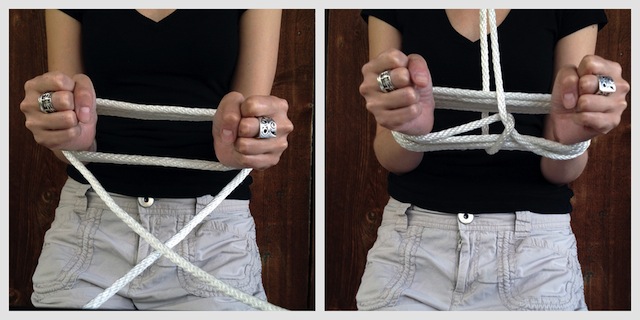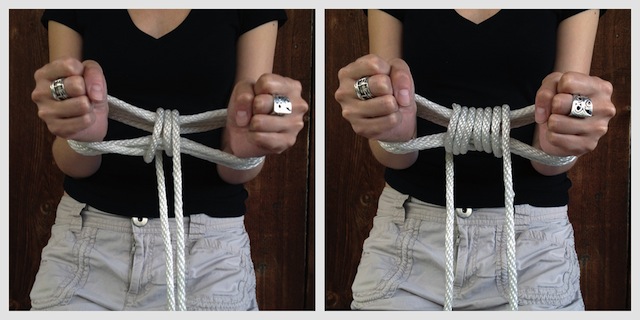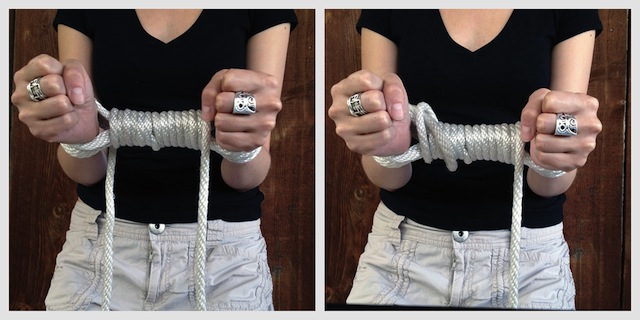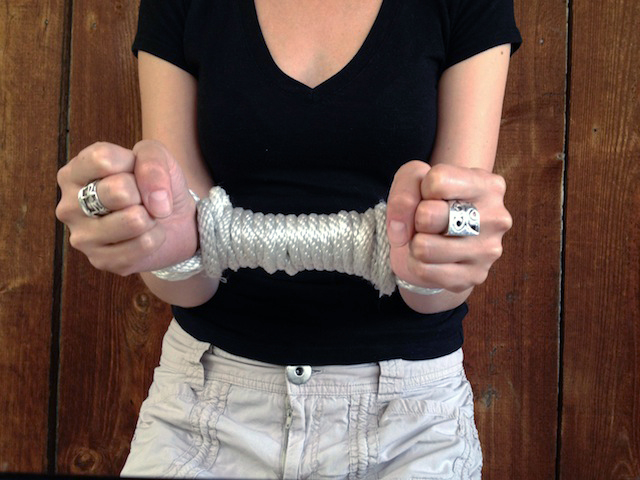Tying people up is fun! But how do you tie someone up? How do you tie up your girlfriend or other activity partner? Here’s how to tie someone up for the first time.
Communication is the key to all kinky play, and it’s absolutely essential when you’re tying someone up. Before any actual bondage takes place, talk to your activity partner about what you like, what you want to try, what you would be willing to try if they’re into it and what’s off limits. A yes/no/maybe list can help. If you’ve never tied someone up or been tied up, you won’t know how you’ll react or what you’ll feel even if you think you do, and it’s okay to slow down and check in often. (If your play involves one partner saying “no” or “stop” and another ignoring it, make sure you have a verbal or physical signalling system that’s obviously out of context, such as using stoplight colors or dropping something small and loud.) The goal is to have fun, but to do that you need to stay safe, sane and consensual, and communication is an important part of it.
Some of the best rope for bondage is thick silk, as it doesn’t slide or move around too much once you tie it off. (Hemp and jute are perfect for shibari.) That kind of rope is expensive though, so unless you’re ready to really invest in rope bondage, go for solid-braid nylon rope around 1/4″ to 7/16″ in diameter from any hardware store or online. Unlike other types of rope, the knots will stay easy to untie even after you pull them around. In an earlier version of this guide, I recommended thick cotton rope, which is readily available, inexpensive and machine washable. However, cotton constricts when it gets wet, such as from sweat or other fluids, so consider other rope options first. Need incentive? Unlike other types of toys, rope is multipurpose. You can make handcuffs like those below, but you can also make your own flogger, strap-on harness or belt, not to mention the infinite ways there are to restrain someone.
Before you begin to tie someone up, keep the following safety tips in mind:
- Keep the rope loose enough that you can work two fingers between the rope and your activity partner’s skin. The goal is to restrain, not to cut off circulation. If the rope might get wet (it’s really hot and you’re both sweating and using cotton rope, for example), leave it even looser.
- Check circulation often by looking for areas of skin that might be turning blue or white. Check in with your activity partner often, and make sure they notify you if they start to feel pins and needles or numbness.
- Never tie rope in a way that might restrict someone’s ability to breathe.
- Never leave someone tied up alone.
- Keep flat edged medical safety scissors near by in case you have to release someone quickly.
Go slowly. If you’re embarrassed to go slowly and feel self-conscious, try something like tying up your activity partner’s hands behind their back — they won’t be able to see what you’re doing or whether you’re secretly checking instructions on your phone, and going slower can feel agonizing in a good way. If you want to pretend to be extra confident, blindfold them.
Today’s rope handcuffs come from Back on the Ropes by Two Knotty Boys, a step-by-step guide to simple and intricate rope bondage. The directions below are for tying someone’s wrists together, but you could also tie someone’s ankles together, or tie wrists to ankles, or wrists or ankles to furniture. The wrap is thick enough that it feels very solid and comfortable, and you can leave ropes dangling to pull your activity partner around by or tuck them in and lead your partner around by pulling on the wrap itself. Or anything else you can think of!
You will need:
- 25 feet of rope
- A willing partner (or an upside down chair to practise on)
- Blunt-edged scissors (just in case)
Directions:
1. Have your partner hold their wrists out with about two fists of space between them. Lay the rope over their wrists so the middle of the rope is roughly between their hands. Wrap each end around twice, for a total of five wraps.

2. Cross the ropes beneath the handcuffs-to-be. Then bring them up and around on the opposite sides from wherever they started (the back rope over the front and the front over the back).

3. Wrap each end of rope around, moving towards your activity partner’s wrists. Stop winding when you still have a small gap between the wrapped rope and their skin. You should end up with an equal number of wraps on each side of the first crossed ropes. If things look a little loose, twist each side in the direction you wound it to tighten everything. You may need to wrap each end once or twice more after.

4. Lift the last loop on the left side and tuck the end of the rope through the resulting circle from inside to out. Repeat on the other side to tie everything off. Pull on both ends of rope to make it secure. You can either tuck the remaining ends into the wrap (if they’re short), or you can use them to tie your activity partner to something else.

Congratulations, you have successfully tied someone up!

For more information, check out Two Knotty Boys Showing You the Ropes and Back on the Ropes. You can also check out Autostraddle‘s Shibari 101, a mini introduction to Japanese rope bondage that walks you through what shibari is, how to practice it safely and what building blocks you need to dive in.
Editor’s note: This post was updated December 2019 with current affiliate links, more comprehensive resources and minor copyedits.







